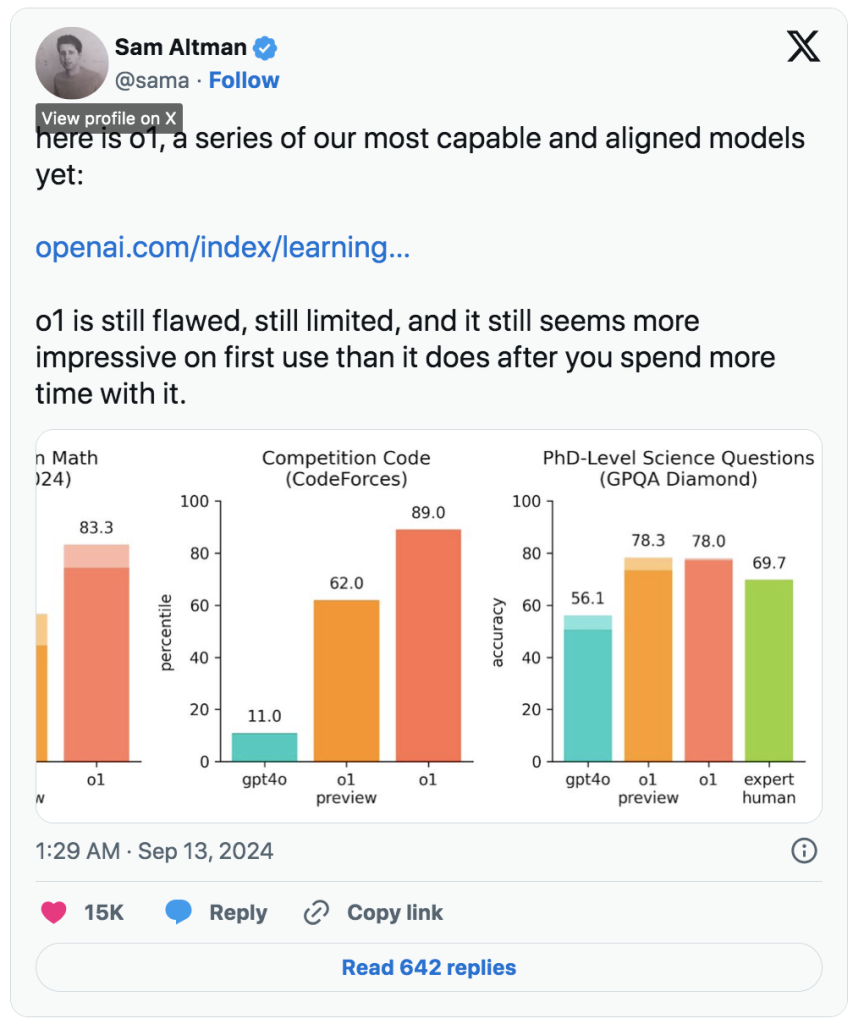
The new AI model, “Strawberry,” is now available and marks a significant advancement in AI reasoning capabilities. This update promises a sweeter and more effective approach to handling complex tasks, pushing the boundaries of what AI can achieve.
OpenAI has unveiled its latest AI model, O1, representing a significant leap in enhancing the reasoning abilities of artificial intelligence. Originally codenamed “Strawberry” during development, this model is designed to tackle more complex tasks, particularly in STEM fields such as physics, chemistry, and biology.
This release is an exciting development for AI enthusiasts, though it comes with certain limitations, as is common with all cutting-edge technologies.
The model performs at a level comparable to that of doctoral students, showcasing its advanced capabilities in complex reasoning tasks.
Performance on a Par with Doctoral Students
OpenAI’s O1 model raises the bar with performance on par with PhD students in handling complex tasks. Early tests reveal the model’s advanced reasoning skills, matching and even surpassing student performance in physics, chemistry, and biology, while also showing strong potential in mathematics and coding.
What sets O1 apart is its ability to adapt its approach to difficult situations. Trained to identify errors and refine its responses, this model excels in analytical tasks. Its focus on “reasoning” enables it to tackle multi-step problems with a thoughtful and deliberate process, distinguishing it from earlier models that were more centered on language generation and simpler tasks.
Key Features and Capabilities
Despite its advanced reasoning abilities, the O1 model has notable limitations. Unlike OpenAI’s GPT-4o, which drives many of ChatGPT‘s advanced features, the O1 model lacks key functionalities such as web browsing, file uploads, and image processing, which are highly useful to users.
Additionally, the O1 model currently lacks support for essential API functionalities, including tool usage, function calling, streaming, and custom system messages. This could be a major drawback for developers and businesses that relied on these features in GPT-4. While O1 excels in reasoning, it is not yet a full replacement for GPT-4 in many practical applications.
Strengthened Protocols

With its enhanced capabilities, OpenAI has ramped up its safety measures. The organization has strengthened internal governance and established closer collaborations with federal governments to ensure the model adheres to safety guidelines. These efforts are aimed at making O1 more compliant with ethical standards, reducing risks, and minimizing harmful outputs.
Availability
Starting today, ChatGPT Plus and Team users can access an early preview of the O1 model by selecting ‘o1-preview’ in the model selector. Additionally, OpenAI is launching the “OpenAI O1 Mini” model, optimized for quicker responses in math and science. This version is specifically designed to tackle technical questions and will be beneficial for both students and professionals.
Next week, both models will be accessible to ChatGPT Enterprise and Education users, broadening availability to a wider audience. Developers will also have the opportunity to prototype with these models via the API, though initial usage will be subject to rate limits and other restrictions.
OpenAI has indicated that the O1 series is just the beginning. Although this model isn’t designed to replace GPT-4 in most applications, OpenAI plans to continuously update the O1 models based on user feedback and ongoing improvements. Expect new features and enhancements to be introduced regularly.
Outlook
The AI landscape is constantly evolving, and the release of the O1 model suggests that OpenAI is pushing the boundaries of what AI can achieve. With upcoming updates and improvements, it will be fascinating to see how this new model develops and where it fits within the broader range of AI tools.